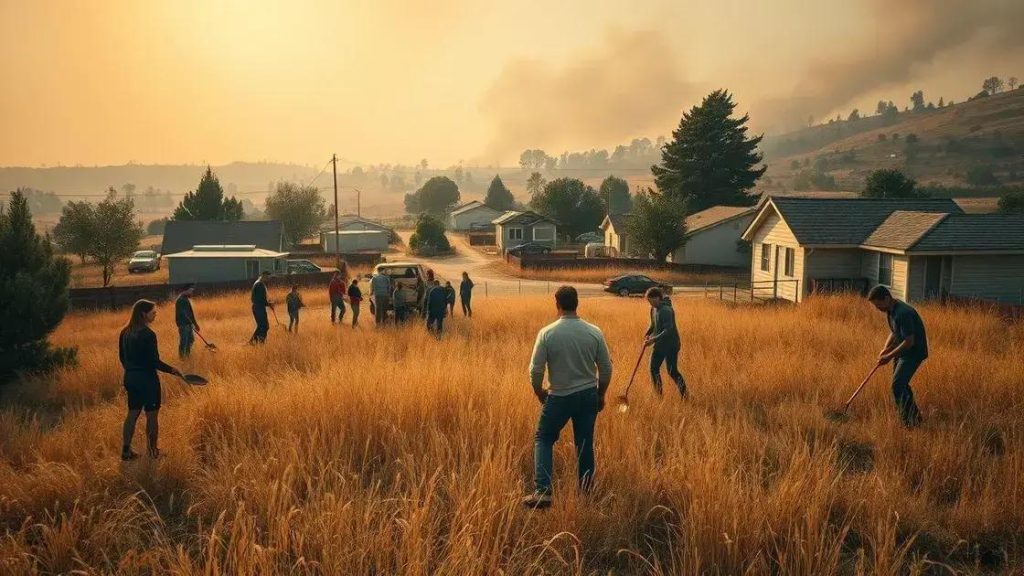Wildfire preparedness initiatives: What you need to know

Wildfire preparedness initiatives involve creating effective evacuation plans, establishing community involvement, and utilizing resources and tools to enhance safety and resilience against fire threats.
Wildfire preparedness initiatives play a crucial role in safeguarding lives and properties during fire season. But, have you considered how these initiatives could impact your community? In this article, we’ll delve into essential strategies and resources that can keep you and your loved ones safe.
Understanding the importance of wildfire preparedness
Understanding the importance of wildfire preparedness is essential for every community. Wildfires can erupt suddenly and cause significant damage, especially in areas susceptible to dry conditions. Therefore, being prepared means being proactive and well-informed.
Why Wildfire Preparedness Matters
Preparedness initiatives help save lives and protect property. When communities are well-prepared, they can respond effectively to emerging threats. An organized approach reduces chaos during an emergency, allowing for quicker and more efficient evacuations.
Key Benefits of Being Prepared
- Increased safety for individuals and families.
- Better resource management and allocation during an emergency.
- Stronger community bonds through shared preparedness initiatives.
- Reduction in property damage and financial losses.
Communities that prioritize wildfire preparedness also experience enhanced resilience. This means they can recover faster after an incident. An active approach to risk management encourages individuals to take tangible steps that protect not only their homes but also their neighbors.
Participating in local wildfire drills gives residents a clear understanding of protocols. This is where communities can unveil their emergency plans. Those plans typically outline what people should do before, during, and after a wildfire event.
Incorporating education about wildfire risks into daily life can significantly benefit communities. When people are aware of the signs of fire danger, they are more likely to act defensively. This can involve creating defensible spaces or securing emergency supplies. More informed residents can also serve as liaisons in assisting others.
Essential Components of Wildfire Preparedness
A comprehensive wildfire plan encompasses various elements. Individuals are encouraged to discuss and tailor these components to suit their specific needs. You might include:
- A clear evacuation route.
- Emergency supply kits with essential items.
- Communication plans to stay connected with family.
By focusing on the importance of wildfire preparedness, communities can cultivate a culture of safety. Engaging the public in these efforts creates a well-informed citizen base, ultimately leading to a less vulnerable population. When everyone plays a role in preparedness, the entire community can thrive.
Key components of effective wildfire plans
When creating effective wildfire plans, it’s important to focus on several key components. Each element plays a role in ensuring safety and preparedness. By understanding these components, communities can mitigate risks effectively.
Creating a Defensible Space
A defensible space around your home is crucial. This area should be free of flammable materials. Regularly maintaining the vegetation can significantly decrease fire risk. Areas around shrubs and trees need to be monitored carefully, especially during dry seasons.
Emergency Supply Kit Essentials
Every household should have an emergency supply kit ready. This kit should include:
- Non-perishable food and water for at least three days.
- A flashlight and fresh batteries.
- A first aid kit including medical supplies and prescriptions.
- A multi-tool or utility knife.
Having these supplies can make a significant difference during an emergency.
Additionally, maintaining communication plans is essential for families during crises. This involves knowing how to reach each other and where to meet if evacuation becomes necessary. Establishing a clear communication method helps reduce panic.
Regular Community Drills
Communities that conduct regular drills are well-prepared. These drills train residents on the proper evacuation routes and procedures. Engaging in practice sessions helps residents feel more confident. They become familiar with the steps to take during an actual wildfire event.
Another component to consider is creating an evacuation plan. This plan must outline the safest routes to leave the area. It’s beneficial to map out various routes in case one becomes blocked during a fire.
Staying Informed About Wildfire Risks
It’s vital to stay informed about local fire conditions. Residents should keep an eye on reports during dry seasons. Understanding local fire danger ratings can help individuals decide on safety measures. Additionally, familiarizing oneself with local authorities and their alerts can provide timely information.
By focusing on these key components, communities can establish effective wildfire plans. Preparedness is not just an individual effort; it involves every member of the community working together towards a common goal of safety.
Community involvement in wildfire initiatives

Community involvement in wildfire initiatives is essential for enhancing preparedness and resilience. When residents engage actively, they play a vital role in promoting safety throughout their neighborhoods.
The Role of Local Groups
Local organizations can lead efforts in education and outreach. They help spread awareness about fire risks and how to mitigate them. Workshops on fire safety can be initiated to teach community members about creating defensible spaces around their homes.
Building Strong Networks
Networking within the community fosters support during emergencies. Residents can form groups that focus on disaster readiness. These relationships enable quicker notifications about changing fire conditions, allowing families to act more swiftly. Groups are also useful for sharing resources, such as tools and equipment needed for fire prevention.
Volunteering for Fire Safety Programs
Volunteering for local fire safety programs can make a significant difference. Engaged community members often assist firefighters with controlled burns and vegetation management. Participation in these activities not only supports the efforts of fire service professionals but also educates volunteers about fire ecology.
In addition, sharing information about local initiatives helps increase participation and awareness. When people understand how to contribute, they are more likely to get involved. This can include participating in community clean-up days to clear brush and dead vegetation.
Organizing Fire Safety Events
Community events focused on fire safety bring people together and create a sense of belonging. These events can include:
- Fire safety fairs with demonstrations.
- Family-friendly educational activities.
- Workshops on creating emergency plans.
Such gatherings allow residents to learn vital skills while fostering community spirit. They also help highlight local resources available for wildfire preparedness.
By actively participating in wildfire initiatives, communities not only improve their safety but also build stronger ties. This connectedness leads to better coordination during emergencies, making the entire area more resilient to wildfires.
How to create a personal evacuation strategy
Creating a personal evacuation strategy is essential for safety during wildfire events. An effective strategy helps ensure that you and your family can leave quickly and safely when needed. Start by assessing your home and neighborhood’s specific risks.
Identifying Escape Routes
It’s important to identify multiple escape routes from your home. This ensures you have options if one route becomes blocked. Consider road conditions and possible traffic points. Familiarize yourself with the roads and paths in your area.
Establishing a Meeting Point
Select a designated meeting point for your family. This should be a safe location away from your home, such as a nearby park or community center. Make sure everyone in your family knows this location. This will keep everyone organized during an emergency evacuation.
Packing an Emergency Kit
Your emergency kit should include:
- Important documents like identification and insurance papers.
- A supply of food and water for three days.
- Clothing and any necessary medications.
- A flashlight and a battery-powered radio.
Keep this kit easily accessible. You may need to grab it quickly as you evacuate.
Regular drills can help your family practice the evacuation plan. This training ensures everyone knows what to do when a wildfire threatens your area. It can also reduce panic and uncertainty when time is of the essence.
Staying Informed
Utilizing local alert systems is vital for staying updated on wildfire risks. Many communities have systems that send alerts via text or email. Make sure to sign up for these notifications, as they can provide crucial information about when to evacuate.
In addition, reviewing weather conditions and fire danger ratings regularly will help you stay prepared. When you know the risks, you can adjust your plans accordingly.
By combining these elements, your personal evacuation strategy will become a valuable tool for ensuring safety during wildfire emergencies. Prepared families can take action quickly and effectively, minimizing risks and protecting loved ones.
Resources and tools for wildfire readiness
Having the right resources and tools for wildfire readiness is crucial for keeping you and your community safe. Many organizations offer helpful materials and guidance to prepare for fire events efficiently.
Educational Materials
Various organizations provide educational resources on wildfire safety. These materials can help families understand fire risks and the best practices to reduce them. Online platforms often host webinars and workshops focused on wildfire preparedness, covering topics like creating defensible spaces and evacuation plans.
Emergency Kits
One essential tool is a well-stocked emergency kit. This kit should include:
- Water and non-perishable food for at least three days.
- A first aid kit with necessary medical supplies.
- Flashlights, batteries, and a portable phone charger.
- Important documents like identification and insurance information.
Preparing this kit in advance ensures that you can respond quickly during an emergency.
Mobile Apps and Alerts
Utilizing mobile apps can be incredibly beneficial. Many apps provide real-time alerts about fire danger in your area. They also offer tips for emergency preparedness and tracking weather conditions. Make sure to enable notifications to stay informed.
Local fire departments often have resources available for the community. These may include guides on fire safety, checklists for home assessments, and contacts for further assistance in creating a preparedness plan. Engaging with these local resources strengthens community ties.
Social Media and Local Networks
Joining local social media groups can keep you connected with your community. These platforms often share updates on wildfire risks, preparedness events, and safety tips. Networking with neighbors increases awareness and fosters cooperation during emergencies.
By utilizing available resources and tools, you can enhance your level of wildfire readiness. Being prepared means having access to knowledge, supplies, and support systems that can make all the difference in critical situations.
FAQ – Frequently Asked Questions about Wildfire Preparedness
What should I include in my emergency kit for wildfires?
Your emergency kit should include water, non-perishable food, a flashlight, first aid supplies, and important documents.
How can I involve my community in wildfire preparedness?
You can organize community drills, educational workshops, and share resources to raise awareness and prepare collectively.
What steps should I take to create a personal evacuation plan?
Identify multiple escape routes from your home, establish a meeting point, and regularly practice your plan with your family.
How can I stay updated on wildfire risks in my area?
Sign up for local alerts, use mobile apps for weather updates, and follow community announcements to stay informed.





